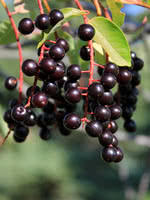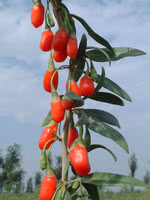Mon-Fri 9am - 5pm Mountain time
Western Chokecherry vs Goji Berry
Prunus virginiana var. demissa
Lycium barbarum
NOT AVAILABLE THIS SEASON - MIGHT RETURN
Western Chokecherry is a shrub or small tree commonly used for farmstead and field windbreaks.
It produces white flowers in the spring and edible dark purple fruit that matures between September and October. Its cherries are great for making for making jams, jellies or wine, but are not very palatable for raw eating.
Goji Berry is a woody, deciduous perennial known for its hearty, bright orange-red berries. It typically produces light lavender flowers from June through September, with fruit maturation taking place between August and October.
Goji Berry berries are delicious, nutrient rich, high in antioxidants, and are often called a super fruit. Many describe their flavour as being like a tart cherry tomato.
Western Chokecherry Quick Facts
Goji Berry Quick Facts
Toxicity: toxic to horses, cattle, etc.)

